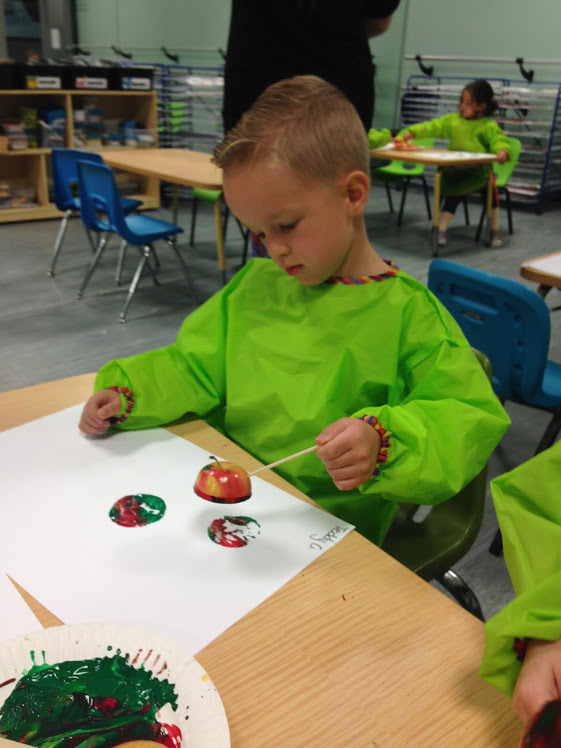“Don’t play with your food! It’s bad manners!”
We’ve had this concept drilled into us from the time we were small, and chances are that we’re drilling it into our children too. And while we don’t think every meal should be a handsy free-for-all, there are plenty of reasons why playing with food could be a beneficial bonus in your preschooler’s life.
Using More Senses Helps Kids Learn Better
The more senses that are involved in an activity, the more your child is going to learn — and retain. Playing with food allows your child to see, smell, feel, hear (what does it sound like when you squish a pea or snap a pretzel?), and even taste. This sensory experience helps with language development, problem solving skills, concentration, and comfort in trying new things.
Playing with Food Decreases Food Battles
We often get into battles of wills at the dinner table. “Eat three more bites, and you can have dessert/go play with your friend/watch a show.” But kids know you can’t actually force them to eat, and so it’s common for them to choose a meal as a time to exert their independence.
Playing with their food removes the battle and gives children a sense of control. It helps them develop curiosity about the food and approach it on their own terms.
Give your child more opportunities to play with new foods, and you may see less resistance during meals.
Playing with Food Helps with Food Aversions
If you have a picky eater, you know how tough it is to get them to try anything new. Letting children play with food lets them experience the food through different senses. They’ll feel the textures with their hands instead of their tongues, which is much more approachable. They may take the time to smell the food or inspect it visually.
And when playing is allowed, pressure is off. This gets your child comfortable with the food so that when it’s presented as a consumable part of a meal, they may be more willing to try it.
Kids Learn Through Play
Kids learn about their world through play. They learn cause and effect, bravery, language development, and so much more. When a child is allowed to play with a food, they’ll learn more about that food. They might ask curious questions, or become fascinated by the food’s details. Again, this will help them get more comfortable with unfamiliar foods.
Let your child guide goldfish crackers on a swim through a new soup. Use bell peppers or apples as sponges for paint. Set broccoli up as a forest for your child’s small animal toys.
But Isn’t It Wasteful to Play with Food?
“You’ll finish your dinner because there are starving children in _______ (fill in the blank).”
Many of us heard this when we were growing up, and it’s a fair point. How can we play with food, when children around the world don’t have enough to eat on a daily basis?
Katie from Preschool Inspirations offers some grounding perspective. She points out that in the United States, we are surrounded by wealth and abundance. Taking showers, driving cars, shopping in a supermarket, and more are all privileges we freely enjoy. And while we know these privileges aren’t available to everyone, we still don’t deprive ourselves of them.
This doesn’t mean we should use our resources wastefully with no regard to anybody else. But perhaps it’s a good idea to focus our efforts on making a difference, like donating generously to someone in need.
Katie also suggests that when playing with food, to use foods that are expired, food that would have been thrown away (maybe you spilled a bag of pretzels or maybe the apple is too bruised), and foods that benefit nature — like birdseed projects done outdoors.
How to Play with Food
- Let your child cook with you. Try your best not to stress out over messes; this is part of the sensory process.
- Choose fun ways to present food from time to time. Put chicken on kabob sticks, arrange fruit in rainbow order, cut food into different shapes, let your children build their own tacos, etc.
- Use food as the subject of an art project. While you prepare dinner, leave an extra cucumber or broccoli stem on the counter and ask your child to draw or paint it. Tell your child to give it arms and legs, change its color, or even come up with a story about their drawing.
- Have a fun taste test. Choose different food items you know your child likes, and take turns being blindfolded while feeding each other bites of the food. Everyone will have fun as you guess what you’re tasting.
- Pick your favorites. Buy several types of one kind of food — apples are a good idea. Taste each variety, and vote on your favorites.
- Before a bite, ask your child what that food will sound like when it’s chewed. Will it be crunchy, soundless, squishy? Similarly, ask your child to describe its appearance or smell.
- Make food into a math problem. Ask your child to count their grapes on their plate. Then ask them how many will be remaining if they eat one. What about two?
- Have your child help you make dinner more colorful. What foods can you add to your chicken dinner to make your plates more like the rainbow?
- String cereal on yarn.
- Use apples, bell peppers, or potatoes as painting stamps.
- Use food as checker pieces.
- Make faces with different food items.
- Play with pretend food. Invent the wackiest recipes you can.
At UDA Creative Arts Preschool, we eat healthy snacks every day and give the children opportunities to play with their food, prepare their own food, and try new foods. To learn more about UDA Creative Arts Preschool in Draper, Utah, contact us online or give us a call at (801) 523-5930


















